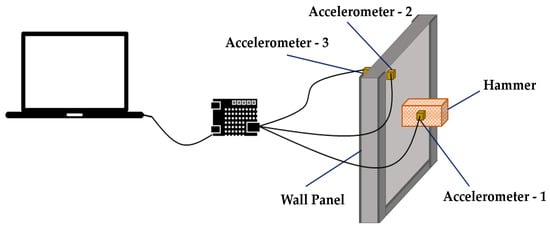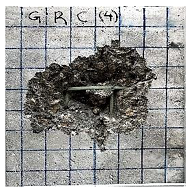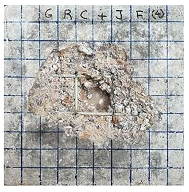Abstract
Structures are often exposed to dynamic loading in the case of accidental impacts. Such scenarios require special precautionary measures to counteract forces induced by these impacts. The goal of this research is to investigate the effect of the addition of jute fibers (JF) in the glass-fiber-reinforced polymer (GFRP) rebar-reinforced concrete wall for possible absorption of impact energy. Concrete was prepared for the testing of mechanical, dynamic, and impact properties of specimens. Mix design was 1:3:2 with a 0.6 water–cement ratio. Jute fibers measuring 50 mm in length were added as a replacement of 5% of cement mass. Wall panels were reinforced with a mesh of 350-mm-long GFRP rebars measuring 6 mm in diameter. A 2.925 kg hammer was used to perform impact strikes at the center of a three-edge supported wall panel in a modified pendulum impact apparatus. The failure criterion was defined as penetration above 25 mm for impact strike quantification. Dynamic properties were evaluated at regular intervals. Accelerometers were mounted at three different locations to assess dissipated energy through wall. Energy dissipation turned out to be greater in jute-fiber-reinforced concrete (JFRC) than plain cement concrete (PC). Monitoring of internal fracturing at regular intervals could be utilized for further investigation of energy dissipation phases.
1. Introduction
Impact load is often accompanied by a high-intensity shock wave requiring dynamic resilience of structures [1,2]. The protection of sensitive facilities and equipment is of primary concern of defense organizations against destructive impact loading [3,4]. Thorough research can be witnessed over the past decades related to utilization of blast-proof walls, as well as anti-penetration and metallic protective systems for the development of economical but safe solutions [5,6]. Numerical and analytical techniques have eased the processes to quantify the impact loading accompanied by shock wave and for derivation of equivalent parameters for small-scale experimental investigations [7,8].
Researchers have utilized experimental procedures for impact loading ranging from small-scale prototype testing to full-scale testing and finite element modeling of impact loads. Contact detonation and bullet/cartridge projectiles have been widely utilized to evaluate the behavior of reinforced concrete [9,10]. Prototype investigation for impact loading has a range of studies on techniques such as free fall/instrumented drop-weight and pendulum impact [11,12,13]. Defining parameters in such experimental procedures—such as impact weight, impact velocity, distance from the launch of impact, and characteristics of impact loading (axial, lateral or projectile)—are taken into consideration for the accuracy of results. Researchers utilize these parameters in finite element modeling and numerical studies of impact loading [14,15,16]. Reference [17] employed compression testing on confined columns reinforced with GFRP rebars. The longitudinal GFRP rebars provided good resistance to compressive stresses in excess of 700 MPa and lateral GFRP rebars aided concrete confinement more efficiently than steel. Reference [18] investigated the axial impact resistance of concrete columns confined with CFRP and GFRP. The GFRP columns revealed a significant enhancement in strength and ductility against impact as compared to CFRP.
Natural fibers—being one of the significant wastes of agriculture—are extensively used by researchers as an additive for achieving sustainable and cost-effective composites. Natural fibers are beneficial in delaying the failure period of composite due to the enhanced capacity of energy absorption. This ability is referred to as the ‘toughness index’, and it can be applied for structures meant to support fewer loads or elements for architectural purposes [19,20,21,22]. Utilization of natural fibrous plaster can greatly enhance the resistance against lateral movements and natural-fiber-reinforced polymer stirrups can act better in shear resistance [23]. However, the durability of natural fibers is still an answerable question for vast applications of reinforced concrete. Ageing effects and freeze–thaw cycles have been investigated by researchers in this context [24,25,26,27]; however, protection of natural fibers from decaying still requires long-term studies. Hybrid-fiber-reinforced concrete is also one of the popular remedies to provide better resistance to cracking, as well as decomposition of fibers. Jute fibers increase the mechanical and dynamic properties of composites in addition to delaying crack initiation and propagation [28,29].
To the best of authors’ knowledge, no study has yet been conducted to investigate the impact load energy dissipation in GFRP-reinforced JFRC wall panels. Thus, the effectiveness of JF in concrete for impact resistance needs to be investigated.
2. Experimentation
Concrete was prepared with a mix design of 1:3:2 (cement:aggregate:sand) and a water–cement ratio of 0.6. For PC and JFRC, a similar mix design ratio and water–cement ratio were employed in addition to jute fibers measuring 50 mm, replacing 5% of the cement mass for JFRC. The slump value was obtained by performing the standard method as per [30]. It justified the addition of jute fibers by increasing the slump value of JFRC (58 mm) which was 61% more as compared to PC (36 mm). For basic mechanical and dynamic properties, cylinders and beamlets were prepared as per standard procedure stated in ASTM standards. Wall panels measuring 375 × 375 × 50 mm in size were prepared with both PC and JFRC, incorporating a mesh of 350-mm-long GFRP rebars with a 6-mm diameter. Dynamic properties were investigated as per [31], followed by mechanical properties for cylinders and beamlets.
For wall panels, failure stages were predefined to obtain dynamic properties at intervals during the application of impact loading. A 2.925 kg hammer was used to perform impact strikes on a three-edge supported wall panel, in a modified pendulum impact apparatus. Damage produced or penetration of the wall panel above 25 mm was defined as the failure stage. Accelerometers at three different locations (at the hammer, at the top right corner of the impact-facing side of the wall, and another one across the panel at the same location) were used to assess the variation of impact energy dissipation as shown in Figure 1.

Figure 1.
Data acquisition using accelerometers and MATLAB program.
3. Results and Analysis
Dynamic test results of the JFRC clearly indicated its improved performance in terms of damping that justifies its usefulness in absorbing energy. The damping ratio (%) of JFRC came out to be 3.5 and 6.2 as compared to 2.8 and 4.7 of PC for beamlets and cylinders, respectively. The flexural, compressive, and split-tensile strengths of JFRC came out to be 2.3, 11.33, and 5.94 MPa in comparison to 4.23, 13.11, and 8.69 MPa of PC, respectively, as shown in Table 1. Table 2 shows the impact resonance, impact test results, and damaged wall panels. The damping ratio of JFRC with GFRP rebar was 14.2% as compared to 12.4% of PC. Similarly, the impact strikes of JFRC with GFRP rebar were 128 strikes as compared to 53 strikes of PC, indicating the effectiveness of the bonding of the fiber–concrete matrix as an impact energy absorbent.

Table 1.
Basic mechanical and dynamic properties.

Table 2.
Impact resonance, impact test, and damage results.
The damaged specimens show a noticeable portion of concrete spelled out GFRP reinforced PC and fibers emerging out of the concrete in GFRP reinforced JFRC. Figure 2 shows the recorded accelerations at the first and last hammer. The comparison is made to show the acceleration or energy transfer through a specimen with an intact internal structure to one with disturbed internal structure due to impact strikes. It is evident from the acceleration time graphs of location 2 and 3 that the wave propagation time of JFRC is greater than that of PC because of the damping induced due to the addition of jute fibers. Furthermore, there is significant increment in recorded acceleration as the effect progresses from location 1 to location 3.

Figure 2.
Recorded acceleration response at locations 1, 2, and 3.
Table 3 shows the recorded accelerations and their percentage increment. In the case of GFRP-reinforced PC, the recorded acceleration increased up to 24.2%; while in GFRP-reinforced JFRC, the recorded acceleration increased up to 26.1%, validating the effectiveness of jute fiber addition as well as confirming the performance of an internally intact structure of wall and internally disturbed structure of wall in transferring acceleration and releasing energy. Similarly, at location 3, the GFRP reinforced JFRC had an increment of 6% in recorded acceleration.

Table 3.
Variation in acceleration response.
Promising results obtained from the investigation indicate the capability of JFRC for dissipating energy, as well as increasing response time. Furthermore, the resistance against impact strikes makes a huge difference between PC and JFRC in penetration failure. It is to be noted that this investigation has been performed with the lowest possible thickness of wall. By increasing its thickness, as well as enhancing the reinforcement, performance might improve extensively.
4. Conclusions and Recommendations
This study intended for relative comparison was conducted to investigate the behavior and performance of PC and JFRC against impact loading. Results obtained from the experimentation against dynamic properties, mechanical properties, and impact strikes were extensively analyzed and compared to assess the relative behavior of PC and JFRC. For JFRC, the mechanical properties obtained show a decrease in flexural, compressive, and split-tensile strength; however, an increase in damping has been noticed in comparison to PC. Clearly, the impact strength of GFRP rebars reinforced JFRC turned out to be much greater than GFRP rebars reinforced PC which shows the usefulness of jute fibers in absorbing impact energy. The recorded acceleration data show that the addition of jute fibers can play a crucial role in energy dissipation for structures that are prone to impact loading. An efficient fiber–concrete matrix and suitable geometrical parameters for walls requires thorough investigation for a more viable solution.
Author Contributions
Conceptualization, S.A.; Methodology, S.A. and M.A.; Investigation and data curation, S.A.; Writing—original draft preparation, S.A.; Writing—review and editing, S.A. and M.A.; Supervision, M.A. All authors have read and agreed to the published version of the manuscript.
Funding
This research received no external funding.
Institutional Review Board Statement
Not applicable.
Informed Consent Statement
Not applicable.
Data Availability Statement
Not applicable.
Acknowledgments
The authors are grateful to the lab staff for administrative support. The valuable guidance of re-search group members in data extraction and data processing is appreciatively acknowledged.
Conflicts of Interest
The authors declare no conflict of interest.
References
- Sung, S.-H.; Ji, H.; Chong, J. Experimental–theoretical investigation for damage assessment of a reinforced concrete slab under consecutive explosions based on single-degree-of-freedom model. Int. J. Prot. Struct. 2020, 12, 95–109. [Google Scholar] [CrossRef]
- Del Linz, P.; Fung, T.C.; Lee, C.K.; Riedel, W. Response mechanisms of reinforced concrete panels to the combined effect of close-in blast and fragments: An integrated experimental and numerical analysis. Int. J. Prot. Struct. 2020, 12, 49–72. [Google Scholar] [CrossRef]
- Jing, L.; Liu, K.; Su, X.; Guo, X. Experimental and numerical study of square sandwich panels with layered-gradient foam cores to air-blast loading. Thin-Walled Struct. 2021, 161, 107445. [Google Scholar] [CrossRef]
- Li, Z.-X.; Zhang, X.; Shi, Y.; Wu, C.; Li, J. Finite element modeling of FRP retrofitted RC column against blast loading. Compos. Struct. 2021, 263, 113727. [Google Scholar] [CrossRef]
- Ishchenko, A.; Afanas’eva, S.; Belov, N.; Burkin, V.; Zakharov, V.; Zykova, A.; Sammel, A.Y.; Skosyrskii, A.; Stepanov, E.Y.; Tabachenko, A. A Study of the Protective Properties of a Combined Cermet Material upon a High-Speed Impact. Tech. Phys. 2020, 65, 925–934. [Google Scholar] [CrossRef]
- Zhang, W.; Di, B.; Song, D. Research Progress of Anti-Penetration Yaw Technology for Concrete Protective Structures. IOP Conf. Ser. Mater. Sci. Eng. 2020, 768, 032017. [Google Scholar] [CrossRef]
- Grisaro, H.Y.; Edri, I.E.; Rigby, S.E. TNT equivalency analysis of specific impulse distribution from close-in detonations. Int. J. Prot. Struct. 2020, 12, 315–330. [Google Scholar] [CrossRef]
- Costa, E. Implementation of an empirical tool for fast prediction of bomb airblast loading. Int. J. Prot. Struct. 2018, 10, 54–72. [Google Scholar] [CrossRef]
- Yao, W.; Sun, W.; Shi, Z.; Chen, B.; Chen, L.; Feng, J. Blast-resistant performance of hybrid fiber-reinforced concrete (HFRC) panels subjected to contact detonation. Appl. Sci. 2019, 10, 241. [Google Scholar] [CrossRef]
- Li, P.; Brouwers, H.; Yu, Q. Influence of key design parameters of ultra-high performance fibre reinforced concrete on in-service bullet resistance. Int. J. Impact Eng. 2019, 136, 103434. [Google Scholar] [CrossRef]
- Yao, Y.; Silva, F.A.; Butler, M.; Mechtcherine, V.; Mobasher, B. Tensile and Flexural Behavior of Ultra-High-Performance Concrete (UHPC) under Impact Loading. Int. J. Impact Eng. 2021, 153, 103866. [Google Scholar] [CrossRef]
- Sadraie, H.; Khaloo, A.; Soltani, H. Dynamic performance of concrete slabs reinforced with steel and GFRP bars under impact loading. Eng. Struct. 2019, 191, 62–81. [Google Scholar] [CrossRef]
- Hussain, T.; Ali, M. Improving the impact resistance and dynamic properties of jute-fiber-reinforced concrete for rebars design by considering tension zone of FRC. Constr. Build. Mater. 2019, 213, 592–607. [Google Scholar] [CrossRef]
- Huang, H.; Gao, X.; Khayat, K.H. Contribution of fiber orientation to enhancing dynamic properties of UHPC under impact loading. Cem. Concr. Compos. 2021, 121, 104108. [Google Scholar] [CrossRef]
- Li, R.; Zhou, D.; Wu, H. Experimental and numerical study on impact resistance of RC bridge piers under lateral impact loading. Eng. Fail. Anal. 2019, 109, 104319. [Google Scholar] [CrossRef]
- Ahmed, N.; Xue, P. Determination of the size of the local region for efficient global/local modeling in a large composite structure under impact loading. Int. J. Impact Eng. 2020, 144, 103646. [Google Scholar] [CrossRef]
- Sheikh, S.A.; Kharal, Z. Replacement of steel with GFRP for sustainable reinforced concrete. Constr. Build. Mater. 2018, 160, 767–774. [Google Scholar] [CrossRef]
- Pham, T.M.; Hao, H. Axial impact resistance of FRP-confined concrete. J. Compos. Constr. 2017, 21, 04016088. [Google Scholar] [CrossRef]
- Mahmood, A.; Noman, M.T.; Pechočiaková, M.; Amor, N.; Petrů, M.; Abdelkader, M.; Militký, J.; Sozcu, S.; Hassan, S.Z.U. Geopolymers and Fiber-Reinforced Concrete Composites in Civil Engineering. Polymers 2021, 13, 2099. [Google Scholar] [CrossRef]
- Mohamed, S.; Zainudin, E.; Sapuan, S.; Azaman, M.; Arifin, A. Energy behavior assessment of rice husk fibres reinforced polymer composite. J. Mater. Res. Technol. 2019, 9, 383–393. [Google Scholar] [CrossRef]
- Ali, M.; Liu, A.; Sou, H.; Chouw, N. Effect of Fibre Content on Dynamic Properties of Coir Fibre Reinforced Concrete Beams. In Proceedings of the NZSEE Conference, New Zealand, 6 March 2010; Annual Australian Earthquake Engineering Society (AEES): Newcastle, Australia, 2010; pp. 1–8. [Google Scholar]
- Ali, M.; Chouw, N. Coir fibre and rope reinforced concrete beams under dynamic loading. In Proceedings of the Annual Australian Earthquake Engineering Society Conference, Newcastle Earthquake–20 Years on, Newcastle, Australia, 11–13 December 2009. [Google Scholar]
- Luo, G.; Li, X.; Zhou, Y.; Sui, L.; Chen, C. Replacing steel stirrups with natural-fiber-reinforced polymer stirrups in reinforced concrete Beam: Structural and environmental performance. Constr. Build. Mater. 2021, 275, 122172. [Google Scholar] [CrossRef]
- De Klerk, M.; Kayondo, M.; Moelich, G.; de Villiers, W.; Combrinck, R.; Boshoff, W. Durability of chemically modified sisal fibre in cement-based composites. Constr. Build. Mater. 2020, 241, 117835. [Google Scholar] [CrossRef]
- Sivaraja, M.; Velmani, N.; Pillai, M.S. Study on durability of natural fibre concrete composites using mechanical strength and microstructural properties. Bull. Mater. Sci. 2010, 33, 719–729. [Google Scholar] [CrossRef]
- Lima, H.C.; Willrich, F.L.; Barbosa, N.P.; Rosa, M.A.; Cunha, B.S. Durability analysis of bamboo as concrete reinforcement. Mater. Struct. 2007, 41, 981–989. [Google Scholar] [CrossRef]
- John, V.M.; Cincotto, M.A.; Sjöström, C.; Agopyan, V.; Oliveira, C.T. Durability of slag mortar reinforced with coconut fibre. Cem. Concr. Compos. 2005, 27, 565–574. [Google Scholar] [CrossRef]
- Zhang, T.; Yin, Y.; Gong, Y.; Wang, L. Mechanical properties of jute fiber-reinforced high-strength concrete. Struct. Concr. 2020, 21, 703–712. [Google Scholar] [CrossRef]
- Zakaria, M.; Ahmed, M.; Hoque, M.M.; Islam, S. Scope of using jute fiber for the reinforcement of concrete material. Text. Cloth. Sustain. 2017, 2, 11. [Google Scholar] [CrossRef]
- C143. Standard Test Method for Slump of Hydraulic-Cement Concrete; ASTM International: West Conshohocken, PA, USA, 2012.
- C215-14. Standard Test Method for Fundamental Transverse, Longitudinal, and Torsional Resonant Frequencies of Concrete Specimens; ASTM International: West Conshohocken, PA, USA, 2014.
Publisher’s Note: MDPI stays neutral with regard to jurisdictional claims in published maps and institutional affiliations. |
© 2022 by the authors. Licensee MDPI, Basel, Switzerland. This article is an open access article distributed under the terms and conditions of the Creative Commons Attribution (CC BY) license (https://creativecommons.org/licenses/by/4.0/).

